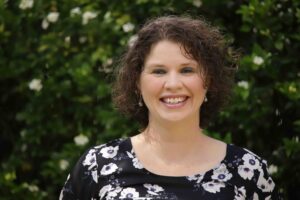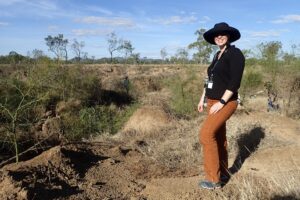Exploring the complexities of sediment run-off from eroded gullies, how it impacts one of the world’s most iconic coral reefs and developing a simple modelling tool to accelerate mitigation efforts is the focus of a new project led by Griffith University, which has just been awarded $1.03 million in funding.
Dr Melanie Roberts, from Griffith’s Australian Rivers Institute, and industry partner the Queensland Department of Environment and Science received $1,034,832 from the Australian Research Council under the Mid-Career Industry Fellowships scheme to support her project ‘A new catchment gully erosion model for a healthier Great Barrier Reef’.

Dr Melanie Roberts.
Poor water quality – in the form of excess nutrients, sediments and pesticides transported from the catchments – affects the health and recovery of the Great Barrier Reef (GBR) in a variety of ways.
Sediment in the water column reduces light that is necessary for sea grass and coral growth, while sedimentation on the sea floor can smother corals and seagrass. High nutrient levels can trigger algal blooms and exacerbate crown-of-thorns starfish outbreaks.
“Recently, in partnership with the Department of Environment and Science and the Queensland Water Modelling Network, we developed the Modelling Erosion Resistance for Gully Erosion (MERGE) model, which provides a simple mathematical tool to test different gully treatments to understand how effective they will be at a specific site,” Dr Roberts said.
“This proposed toolkit will take what we are learning from the local MERGE model and scale it to inform land management and investment at the catchment scale.
“By providing the tools to direct actions to where they will be most effective, we will accelerate the impacts of work to reduce the amount of sediments and nutrients that are eroded out of gullies, improving the water quality on the GBR.”
The expected outcomes of the project include a validated land rehabilitation decision making tool, benefiting natural resource managers by increasing the ability to meet Reef 2050 policy targets and landowners though development of Natural Capital Markets.
“Queensland’s land managers and owners have a strong connection to their land and the environment, but they need support to ensure that they are directing efforts where it will be most effective,” Dr Roberts said.
“This tool will help them achieve those goals to prevent erosion.
“Land owners and managers will also be supported in their work by emerging natural capital markets, which are reliant on effective and tested methods to value actions taken to protect the environment.”
Dr Roberts said the rate at which individual gullies are contributing to sediment on the GBR differed greatly. Different regions and types of gullies erode more quickly than others, with the rate of erosion of a single gully varying greatly over the life of the gully.

Dr Roberts in the field.
“What we have observed in the past is not always the best indicator of what will happen at a site in the future,” she said.
“Furthermore, different treatments worked very differently at different sites, making it very complex to direct limited resources to where they will be most effective at reaching the sediment reduction targets.
“Mathematical modelling therefore provides tools to explore and understand systems in ways, and on timescales, that are impractical in the field.
“I love the challenge of balancing the complexities of a real system with the need to simplify to be tractable and practical for my end user.
“The maths itself is fun, but I am mostly driven by the chance to make a difference and provide a tool that will help others in their work — and what better application than protecting the GBR.”



